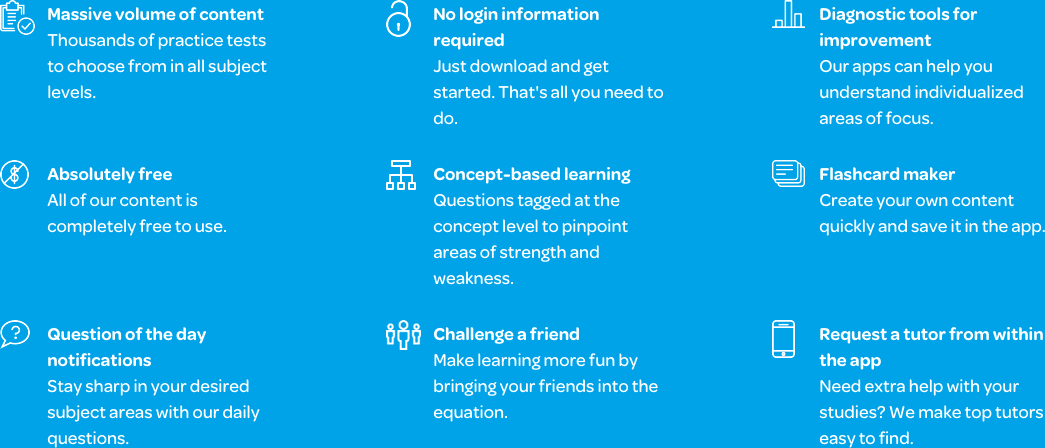The Varsity Tutors AP Statistics Mobile App
Advanced Placement (AP) Statistics is an accelerated class that you can take to demonstrate your potential to succeed in an upper-level statistics courses. During the class, you are trained to interact with data in a variety of ways, such as collection, analysis, and organization. When you take an AP Statistics class, it is imperative that you stay on top of your studies to ensure optimal success. Your score on the exam may provide college credit depending on your future school, along with the credit you’ll earn toward your high school diploma.
The AP Statistics exam provides you with the chance to learn to balance a college-level workload. In addition, you can get a leg up on your post-secondary education by satisfying the introductory requirements for statistics. The class covers several concepts that will help you to hone the skills needed for future courses in statistics. When it comes to preparing for the final exam, the ideal time to do it is throughout the year. However, even if you’re getting a late start, you can still benefit from revisions using the AP Statistics app.
Available on iTunes and the Google Play Store, the content available on the free Varsity Tutors AP Statistics app serves as a user-friendly, challenging study tool that covers the material you’ll find on the real test. You can access a number of full-length, timed practice tests to assess your knowledge on the subject. These provide the visual cues and tables that you will see on testing day.
The app offers detailed explanations of your answers. Through these, you can identify where things may have gone wrong, as well as develop a deeper understanding of the subject rather than simply memorizing the equations. In addition, these questions provide an analysis of your progress, improvement, and the concepts relevant to solving the question. Using these, you can boost your review efficiency through practice exams and flashcards.
There are many concepts interwoven into AP Statistics, all of which are important. You need to be able to identify statistical patterns, determine significance, z-scores, random phenomena, and many other concepts. Through the app, you have access to hundreds of flashcards that can be used for fast-paced study breaks. These may be used to assess your preparation across a range of statistical ideas, such as data exploration, sampling questions, patterns, studies, and more.
The AP Statistics app’s full-length practice tests can be used to identify strengths and weaknesses. Using these free tests, you can determine your preparation level. In addition, it makes for an excellent form of practice at any point of the year. You can begin preparing for your exam using the most convenient materials, and bring a little fun into your study group by creating flashcard-based competitions and games. The Varsity Tutors AP Statistics app is available for Android and Apple devices on the Google Play Store and iTunes.
66 mobile apps to choose from for your tutoring needs.

Learn More
Through AP Statistics, a high school college-level program, you get an introduction to non-calculus-based statistics. In addition, you can earn a college credit in the class, which can free your schedule up for a more advanced course. It can save money and time in the long run. The program's purpose is to educate you on the major ideas and tools of stats. There are four conceptual themes that you'll learn about during the class: patterns and pattern departures, conducting a study, exploration of random phenomena through simulation and probability, and how to inference population parameters and test their own hypotheses.
Students select AP Statistics based on various individual plans. If you are in your sophomore year and intend to take a science class in your final year, you may find that AP Statistics is right up your alley. If you won't have to take a math class, you can use this program to continue developing your quantitative capabilities. It works well when taken alongside precalculus before taking calculus in college. The class can lead to a college major in exercise science, computer science, applied mathematics, education, information science, and more.
At the end of the semester- or year-long class, you receive a three-hour exam to assess your mastery of the techniques and concepts discussed in the course. There are two sections: a 90-minute section with multiple-choice questions, and a 90-minute section of open-answered questions. The multiple-choice section covers the breadth of topics from the statistics course. You may need to analyze points on a chart to identify residuals, differentiate between simple and stratified random samplings, determine probabilities based on percentages, and use descriptive statistics to solve problems. During the second portion of the exam, you are tested on your ability to investigate and extend reasoning into your response. You will be required to have a graphing calculator that has statistical features.
There are four major themes to AP Statistics. Each of these are vitally important to understand for the final exam at the end of the course. By the end of the class you should be able to analyze data and patterns using numerical and graphical techniques, differentiate between causes and association, identify reasonable methods to collect data, use probability to make predictions of data distribution, and select appropriate models to relay data. You will be required to demonstrate your ability to draw conclusions through data models, discuss the interaction between the model and the data, and use diagnostic methods to falsify models.
In AP Statistics, the class focuses on interpretation and understanding of data. The first section of the class involves exploring data and accounts for 20 to 30 percent of the exam. The section introduces you to analysis of data using different techniques. You'll be required to interpret information based on numerical and graphical materials. There are five primary principles that you'll learn during this section of the class. You'll learn how to form and interpret graphs that use singular data plots, such as cumulative frequency, histogram, stemplot, and dotplot. In addition, you will learn to summarize the data, compare different sets of data to one another, and become familiar with categorical and bivariate data sets.
Sampling and experimentation accounts for 10 to 15 percent of the AP Statistics final exam. During this part of the course, you will learn how to properly plan and conduct a full study. It is important that studies have a solid plan behind them in order to identify valid information, collect it properly, provide an interpretation of the validity of the theory, and choose the right method of collection and analysis of the data. You'll be given opportunities to work with observational studies, surveys, and experiments. There are several techniques and ideas that you will learn during the sampling portion, such as census studies, bias sources, control groups, and different randomized block designs.
In the third section of the program, you'll be focusing on patterns and how to anticipate them through probabilities. There are several major principles included in this section. You'll be introduced to the law of large numbers, conditional probabilities, geometric variables and distribution, random behavior simulation, interdependence versus dependence, central limit theorem, sampling distributions, chi-square distribution, and other important aspects of predictions based on patterns. During this section, you perform a variety of simulations based on probability predictions to determine the ideal methods for different forms of data collection and models. You will need to be able to demonstrate the ability to defend your probability reasoning through graphs, charts, data, and other forms of evidence.
During the statistical inference section of AP Statistics, you'll learn how to form hypotheses to create testing opportunities and form population parameters. This means you must be able to estimate population with a margin for error. In addition, you'll learn about the properties of different estimators that can be used to find population parameters, such as variability and unbiasedness. You'll be introduced to the logic of confidence intervals and their properties, how to use large sample confidence intervals for proportion, and how to find the difference between two proportions. Your teacher should focus on significant types of tests and errors, such as a Type I error, which may occur during a hypothesis test. You'll learn the logic of this type of testing and its role in statistics, as well as be introduced to the concept of power, type II errors, two-sided tests, chi-square testing and its uses, and others.
An AP Statistics course uses technology to implement testing, data collection, and other important aspects of conducting studies. You will need to have a graphing calculator that has statistical capabilities to analyze data, determine probabilities, and use simulation strategies during those sections of the class.
Depending on the school or district, your AP Statistics course may be one semester or a full year. There is a lot of information covered during the program, however, passing can provide an opportunity to fulfill a college requirement early, and it can set you on an accelerated path in certain fields of study.




